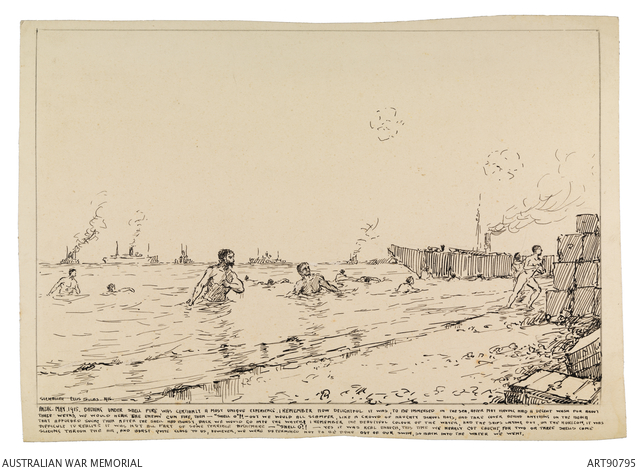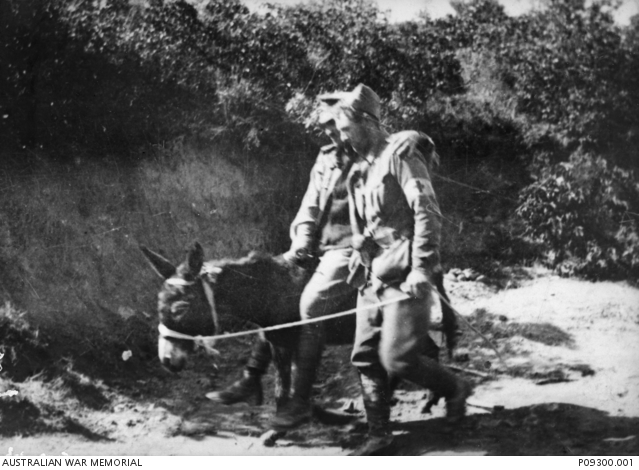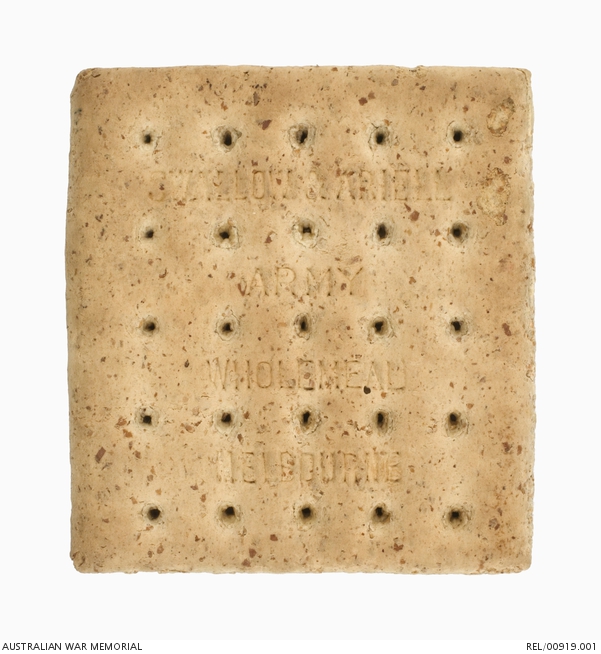Daily life

Life on Gallipoli soon became routine. In the trenches, soldiers observed and sniped at the Turks and engaged them in bombing duels. Bean described the trenches as deep narrow alleys where the men “lived as completely enclosed as in the lanes of a city, having their habitations along them in niches undercut in the wall, sometimes curtained by hanging blankets or waterproof sheets”.
Those not on the front line spent their time carrying water, escorting teams of donkeys carrying supplies from the beach, and fortifying their positions. One of the few diversions available to the Australian troops was a swim off the beach, their only chance to wash. Regardless of the danger of shelling and sniping, Australians swam at Anzac Cove throughout much of the campaign.
The heat early in the campaign prompted the Anzacs to modify their uniforms – and sometimes wear as little as possible. P06127.001
The onset of winter found the men under-prepared. A snow storm at the end of November led to many cases of frostbite. G01263
"It is actually snowing this morning. The first I have ever seen. I woke up to find the whole country white. It looks beautiful and covers over so many things which are not."
Improvisation
Soldiers on Gallipoli were industrious and inventive – they made periscopes, “jam tin” bombs, cooking equipment, board games, and stationery from what they found around them. Initially, they expected a quick advance, so did not carry the equipment or supplies needed for prolonged periods of trench warfare. Later, supplies came in by sea but could be impeded by bad weather or Turkish shelling.
A sniper with a periscope rifle in a trench on Gallipoli. His spotter is using an improvised periscope of his own. C01541
Tending the wounded
Throughout the campaign, the Australian Army Medical Corps (AAMC) found itself consistently undermanned and under supplied. Water for drinking and preparing antiseptics was always scarce, and food suitable for patients was hard to come by. There was also the ever-present danger of gunfire and shrapnel.
The sheer number of wounded during the first few days on Gallipoli caused a breakdown in the system for evacuating them. There were not enough boats available to transport the wounded from the beach to the hospital and transport ships. Medical supplies on board were inadequate, and personnel were rapidly overwhelmed by the number of casualties. A similar breakdown would occur again in August following the high casualties from the fighting at Lone Pine, The Nek, and Hill 971.
Wounded troops on the beach at Anzac Cove on 25 April 1915. Men of the AAMC are treating some of the wounded. PS1659
John Simpson, stretcher-bearer
"Private Simpson has shown great initiation in using a donkey."
Field ambulance stretcher-bearers had difficulty locating the wounded during the first days on Gallipoli. Infantry units were scattered, and the difficult terrain made systematic searches impractical. Many stretcher-bearers set about recovering any wounded men they could find.
One of the most famous stretcher-bearers was John Simpson. Using a donkey, he transported wounded men to the dressing station among shrapnel, rifle, and machine-gun fire. Simpson was killed by machine-gun fire near a place known as Bloody Angle on 19 May 1915. He was Mentioned in Despatches, along with several other stretcher-bearers, for his exemplary courage and devotion to duty.
Simpson working in Shrapnel Gully at Anzac Cove, assisting a wounded soldier. P09300.001
War diary entry
"The behaviour of the men in view of their rude introduction to the circumstances of war was splendid … NO. 202 Private Simpson … has kept up his work from early morning till night every day."
“Shot through heart”
“No. 202 Pte J. SIMPSON, shot through heart, killed, while escorting patient.”
Food and health
There was little variety in food rations, with bully beef and hard tack biscuits as the staple of most meals. These staples were supplemented with bacon, onion, jam, and cheese. Charles Bean described the monotonous rations:
"over-salted 'bully', which, in the heat of midday or afternoon, slipped in its own fat across the platter or mess-tin, swamping stray flies as it went … or for the cheese, greasy from exposure to the sun and filling the dugout with an odour sickeningly reminiscent of that exhaling from the corpses in No-Man’s Land."
Dysentery and paratyphoid broke out in an environment where water and sanitation were rudimentary at best. Swarms of flies carried infection from refuse, latrines, and rotting corpses to food being eaten in unwashed mess tins. Disease was just as much a threat to the troops as the enemy.
The combination of poor nutrition, unsanitary living conditions and lack of rest took their toll. By late July, hundreds of tired and poorly fed men were succumbing to sickness each day, though many refused to be evacuated.
Two unidentified soldiers stand amid boxes of bully beef stacked in a supply depot on the beach at Anzac Cove. The cans in the foreground were used for carrying kerosene or water. H03951
Hard tack biscuits often broke a soldier’s teeth. Sometimes the biscuits were grated or ground up to make porridge or thicken a stew made with bully beef and onions. REL/00919.001









